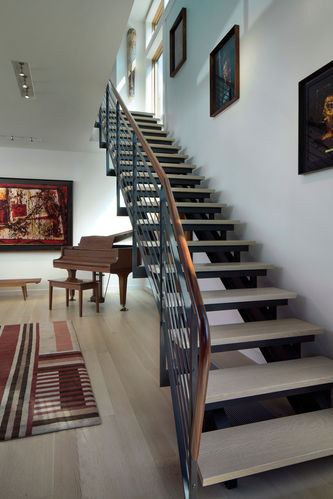
© Tom Bonner
PROJECT DETAILS:
KNOW MORE ABOUT THE DESIGNERS:
The Venice House creates a garden sanctuary in the city. Located on a long, narrow lot in the Venice neighborhood of Los Angeles, the house comprises a dramatic series of folded roof planes and a collage of textured metal and wood exterior surfaces. The bulk of the house has been placed on the eastern side of the lot, making a linear garden on the western side. The wood living pavilion projects into the garden space, with a soaring hyperbolic paraboloid roof formed by exposed Douglas fir beams. A pool has been placed directly outside the living area, allowing this prominent part of the house to be mirrored by water.
The bedroom wing of the house frames the triangular living pavilion, which projects into the long garden space on the west side of the property.
The living area is enclosed by a continuous glass wall, protected by a 6-ft roof overhang. Oversized 8-ft by 10-ft sliding glass panel doors open directly to the pool, creating a seamless indoor-outdoor environment. The living pavilion itself is constructed with wood, both exterior and interior, establishing a contrast of warm wood to the cool metal siding that wraps the bedroom wing. The living roof is a hyperbolic paraboloid composed of tightly-spaced Douglas Fir beams. The beams gradually reverse their slope from one end of the living space to the other end, creating a curving interior line where the beams frame into the wall of the bedroom wing. The curvature of the hyperbolic paraboloid is made entirely with straight beams.
Simplicity rules the choice of interior finishes. White-bleached rift-sawn white oak cabinets and floors are combined with calm, white plaster walls.
The custom FINNE design work can be seen in a delicate custom steel light fixture hanging over the sculptural quartz kitchen island and cast-glass breakfast counter. Other FINNE design elements include a sculptural quartz powder room vanity, the spare steel and wood main stair, and the dense wood screen wall located outside the second-floor master bath. The crafted approach continues on the exterior with a unique handmade Danish brick, creating accent walls at the front entry and the living room fireplace.
The house was designed to be a sustainable structure from the start, with 40% higher insulation values than required by code, efficient natural ventilation, large amounts of natural lighting, water-conserving plumbing fixtures, LED lighting, locally sourced materials, and drought-tolerant landscaping. Windows have high-performance Low-E insulated glazing and are equipped with concealed shades. The house roof has been planned for future photovoltaic panels and hot-water solar panels.
Deep roof overhangs, built-in shades, and high-operating clerestory windows are used to reduce heat gain in the summer months. During the winter, the lower sun angle is able to penetrate into living spaces and passively warm the floor. Low VOC paints and stains have been used throughout the house. The high level of craft evident in the house reflects another key principle of sustainable design: eschew “throw-away-ism” and make the house last for many years!
GALLERY:



















